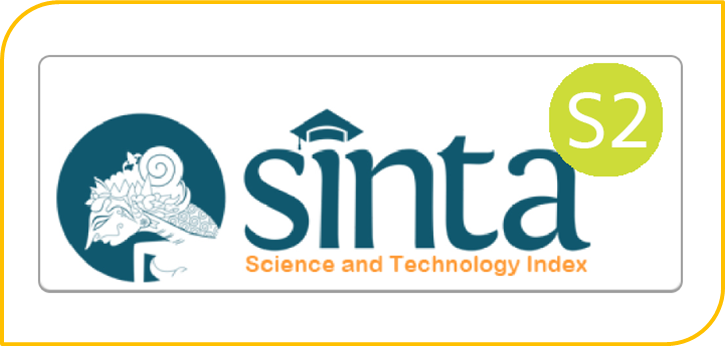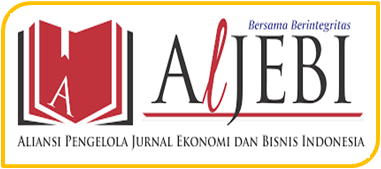DETERMINANT OF CONSUMER DECISION ON ISLAMIC BANKING
Abstract
Keywords
Full Text:
PDFReferences
Aini, A. N., & Safira, A. (2021). Determinants of Indonesian Muslim consumers' willingness to pay for Taiwanese snacks. Journal of Emerging Economies and Islamic Research, 9(2), 102–117. https://doi.org/10.24191/jeeir.v9i2
Akhlaq, A., & Ahmed, E. (2013). The effect of motivation on trust in the acceptance of internet banking in a low income country. International Journal of Bank Marketing, 31(2), 115–125. https://doi.org/10.1108/02652321311298690
Al Abdulrazak, R. M., & Gbadamosi, A. (2017). Trust, religiosity, and relationship marketing: a conceptual overview of consumer brand loyalty. Society and Business Review, 12(3), 320–339. https://doi.org/10.1108/sbr-03-.2017-0014
Alhazmi, B. M. (2019). Religiosity and customer trust in financial services marketing relationships. Journal of Financial Services Marketing, 24(1–2), 31–43. https://doi.org/10.1057/s41264-019-00062-9
Alvarez, B. A., & Casielles, R. V. (2005). Consumer evaluations of sales promotion: The effect on brand choice. European Journal of Marketing, 39(1–2), 54–70. https://doi.org/10.1108/03090560510572016
An, M. a., & Han, S. L. (2020). Effects of experiential motivation and customer engagement on customer value creation: Analysis of psychological process in the experience-based retail environment. Journal of Business Research, 120, 389–397. https://doi.org/10.1016/j.jbusres.2020.02.044
Bao, N., & Volkovynska, A. (2016). Social Commerce Factors that stimulate sellers to engage in C2C commercial activity on social networking platforms Social Commerce: Factors that stimulate sellers to engage in C2C. commercial activity on social networking platforms. 1–98. http://lup.lub.lu.se/luur/download?func=downloadFile&recordOId=8878634&fileOId=8878725
Bloch, M. (2017). Why religion is nothing special but is central. Intelligent Design and Religion as a Natural Phenomenon, 5(1499), 81–87.
Bonab, B. G., Miner, M., & Proctor, M. T. (2013). Attachment to God in islamic spirituality. Journal of Muslim Mental Health, 7(2), 77–104. https://doi.org/10.3998/jmmh.10381607.0007.205
Brown, N. J., & Revkin, M. (2018). 779 Islamic Law and Constitutions. In A. M. Emon & R. Ahmed (Eds.), The Oxford Handbook of Islamic Law (p. 0). Oxford University Press. https://doi.org/10.1093/oxfordhb/9780199679010.013.27
Chan, C., Ananthram, S., Thaker, K., & Liu, Y. (2022). Do religiosity and ethical principles influence ethical decision-making in a multi-faith context? Evidence from India. Journal of Business Research, 149, 772–785. https://doi.org/10.1016/j.jbusres.2022.05.065
Cheng, B. L., & Rashid, Z. A. (2013). Service quality and the mediating effect of corporate image on the relationship between customer satisfactionand customer loyalty in the Malaysian hotel industry. Gadjah Mada International Journal of Business, 15(2), 99–112. https://doi.org/10.22146/gamaijb.5474
Correia Loureiro, S. M. (2019). Promoting Brand Relationships. Journal of Promotion Management, 25(3), 301–303.https://doi.org/10.1080/10496491.2019.1557804
Dahana, W. D., Miwa, Y., Baumann, C., & Morisada, M. (2022). Relative importance of motivation, store patronage, and marketing efforts in driving cross-buying behaviours. Journal of Strategic Marketing, 30(5), 481–509. https://doi.org/10.1080/0965254X.2020.1811997
Delener, N. (1994). Religious Contrasts in Consumer Decision Behaviour Patterns: Their Dimensions and Marketing Implications. European Journal of Marketing, 28(5), 36–53. https://doi.org/10.1108/03090569410062023
Enginkaya, E., & Yılmaz, H. (2014). What Drives Consumers to Interact with Brands through Social Media? A Motivation Scale Development Study. Procedia - Social and Behavioural Sciences, 148, 219–226. https://doi.org/https://doi.org/10.1016/j.sbspro.2014.07.037
Gaetjens, A., Corsi, A. M., & Plewa, C. (2023). Customer engagement in domestic wine tourism: The role of motivations. Journal of Destination Marketing and Management, 27, 100761. https://doi.org/10.1016/j.jdmm.2022.100761
Ghozali, I., & Latan, H. (2015). Partial least squares konsep, teknik dan aplikasi menggunakan program smartpls 3.0 untuk penelitian empiris. Semarang: Badan Penerbit UNDIP.
GIFFIN, K. (1967). The Contribution of Studies of Source Credibility To a Theory of Interpersonal Trust in the Communication Process. Psychological Bulletin, 68(2), 104–120. https://doi.org/10.1037/h0024833
Gorji, M., & Siami, S. (2020). How sales promotion display affects customer shopping intentions in retails. International Journal of Retail & Distribution Management, 48(12), 1337–1355. https://doi.org/10.1108/IJRDM-12-2019-0407
Gurol, M. N., & Bilen, M. H. (2015). The Concept of Promotion Mix as Applied to Hotel Marketing BT. Proceedings of the 1983 Academy of Marketing Science (AMS) Annual Conference (J. C. Rogers III & J. Lamb Charles W. (eds.); pp. 536–540). Springer International Publishing.
Hair, J. F. (2013). Essentials of marketing research. ISBN10: 1260260461
Hanaysha, J. R. (2022). Impact of social media marketing features on consumer's purchase decision in the fast-food industry: Brand trust as a mediator. International Journal of Information Management Data Insights, 2(2), 100102. https://doi.org/10.1016/j.jjimei.2022.100102
Handoko, T. H. (2004). Dasar-dasar Motivasi. Penerbit Liberty, Yogyakarta.
Harahap, B., & Risfandy, T. (2022). Islamic Organization and the Perception of Riba (Usury) and Conventional Banks Among Muslims: Evidence From Indonesia. SAGE Open, 12(2), 21582440221097932. https://doi.org/10.1177/21582440221097931
Hardesty, D. M., & Bearden, W. O. (2003). Consumer evaluations of different promotion types and price presentations: the moderating role of promotional benefit level. Journal of Retailing, 79(1), 17–25. https://doi.org/https://doi.org/10.1016/S0022-4359(03)00004-6
Hayes, A. F. (2017). Introduction to mediation, moderation, and conditional process analysis: A regression-based approach. Guilford publications.
Hennig-Thurau, T., Gwinner, K. P., & Gremler, D. D. (2002). Understanding Relationship Marketing Outcomes: An Integration of Relational Benefits and Relationship Quality. Journal of Service Research, 4(3), 230–247. https://doi.org/10.1177/1094670502004003006
Hong, I. B., & Cha, H. S. (2013). The mediating role of consumer trust
in an online merchant in predicting purchase intention. International Journal of Information Management, 33(6), 927–939.
https://doi.org/10.1016/j.ijinfomgt.2013.08.007
Hoque, H., & Liu, H. (2022). Capital structure of Islamic banks: How different are they from conventional banks? Global Finance Journal, 54, 100634. https://doi.org/10.1016/j.gfj.2021.100634
Hutter, K., Hautz, J., Dennhardt, S., & Füller, J. (2013). The impact of user interactions in social media on brand awareness and purchase intention: the case of MINI on Facebook. Journal of Product & Brand Management, 22 (5/6), 342-351. https://doi.org/10.1108/JPBM-05-2013-0299
Irshad, M., Ahmad, M. S., & Malik, O. F. (2020). Understanding consumers’ trust in social media marketing environment. International Journal of Retail & Distribution Management, 48(11), 1195–1212. https://doi.org/10.1108/IJRDM-07-2019-0225
Kingshott, R. P. J., Chung, H. F. L., Putranta, M. P., Sharma, P., & Sima, H. (2021). Religiosity and psychological contracts in Asian B2B service relationships. Industrial Marketing Management, 98, 138–148. https://doi.org/10.1016/j.indmarman.2021.07.010
Kotler, P., Kartajaya, H., & Setiawan, I. (2019). Marketing 4.0: Bergerak dari Tradisional ke Digital. Gramedia Pustaka Utama.
Kotler, P., & Keller, K. L. (2009). Manajemen pemasaran. Edisi kedua belas. Jilid 1. PT Index. kelompok Gramedia. Jakarta
Kotler, P., & Keller, K. L. (2012). Manajemen Pemasaran Jilid I Edisi ke 12. Jakarta: Erlangga, 27.
Lee, F. K., Sheldon, K. M., & Turban, D. B. (2003). Personality and the goal-striving process: The influence of achievement goal patterns, goal level, and mental focus on performance and enjoyment. Journal of Applied Psychology, 88(2), 256–265. https://doi.org/10.1037/0021-9010.88.2.256
Lim, S., Seetaram, N., Hosany, S., & Li, M. (2023). Consumption of pop culture and tourism demand: Through the lens of herding behaviour. Annals of Tourism Research, 99, 103531. https://doi.org/10.1016/j.annals.2023.103531
Lu, Y., Zhao, L., & Wang, B. (2010). From virtual community members to C2C e-commerce buyers: Trust in virtual communities and its effect on consumers’ purchase intention. Electronic Commerce Research and Applications, 9(4), 346–360. https://doi.org/10.4236/sn.2017.62007
Mayer, R. C., Davis, J. H., & Schoorman, F. D. (1995). An integrative model of organizational trust. Academy of Management Review, 20(3), 709–734. https://doi.org/10.2307/258792
Menne, F., Surya, B., Yusuf, M., Suriani, S., Ruslan, M., & Iskandar, I. (2022). Optimizing the Financial Performance of SMEs Based on Sharia Economy: Perspective of Economic Business Sustainability and Open Innovation. Journal of Open Innovation: Technology, Market, and Complexity, 8(1), 18. https://doi.org/10.3390/joitmc8010018
Min, J., Kim, J., & Yang, K. (2023). CSR attributions and the moderating effect of perceived CSR fit on consumer trust, identification, and loyalty. Journal of Retailing and Consumer Services, 72, 103274. https://doi.org/10.1016/j.jretconser.2023.103274
Minton, E. A. (2015). In advertising we trust: Religiosity’s influence on marketplace and relational trust. Journal of Advertising, 44(4), 403–414. https://doi.org/10.1080/00913367.2015.1033572
Novak, D. (2011). Promotion as instrument of marketing mix. Engineering Management And Competitiveness, 505-510.
Omar, H. N., & Hassan, R. (2019). Shariah Non-Compliance Treatment in Malaysian Islamic Banks. International Journal of Management and Applied Research, 6(4), 220–233. https://doi.org/10.18646/2056.64.19-016
Ozdemir, M., Savasan, F., & Ulev, S. (2023). Leveraging financial inclusion through Islamic microfinance: A new model proposal for participation banks in Turkiye. Borsa Istanbul Review. https://doi.org/https://doi.org/10.1016/j.bir.2023.01.011
Pace, S. (2014). Effects of intrinsic and extrinsic religiosity on attitudes toward products: Empirical evidence of value-expressive and social-adjustive functions. Journal of Applied Business Research (JABR), 30(4), 1227–1238.
Pearce, L. D., Hayward, G. M., & Pearlman, J. A. (2017). Measuring Five Dimensions of Religiosity Across Adolescence. Review of Religious Research, 59(3), 367–393. https://doi.org/10.1007/s13644-017-0291-8
Pham, M. T., & Higgins, E. T. (2005). Promotion and prevention in consumer decision-making: The state of the art and theoretical propositions. Inside Consumption, 30–65. Ed. S. Ratneshwar and David Glen Mick. Abingdon, Oxon: Routledge.
Qoyum, A., Sakti, M. R. P., Thaker, H. M. T., & AlHashfi, R. U. (2022). Does the Islamic label indicate good environmental, social, and governance (ESG) performance? Evidence from Sharia-compliant firms in Indonesia and Malaysia. Borsa Istanbul Review, 22(2), 306–320. https://doi.org/10.1016/j.bir.2021.06.001
Robbins, B. G. (2016). What is Trust? A Multidisciplinary Review, Critique, and Synthesis. Sociology Compass, 10(10), 972–986. https://doi.org/10.1111/soc4.12391
Rowley, J. (1998). Promotion and marketing communications in the information marketplace. Library Review.
Sahay, B. S. (2003). Understanding trust in supply chain relationships. Industrial Management & Data Systems, 103(8), 553–563. https://doi.org/10.1108/02635570310497602
Schiffman, L., & Kanuk, L. L. (2008). Perilaku Konsumen, Edisi ke-7. Jakarta: PT Indeks.
Shahid, A. U., Patel, C., & Pan, P. (2022). Corporate social responsibility, intrinsic religiosity, and investment decisions. Journal of Behavioural and Experimental Finance, 34, 100650. https://doi.org/10.1016/j.jbef.2022.100650
Sharma, S. K., & Sharma, M. (2019). Examining the role of trust and quality dimensions in the actual usage of mobile banking services: An empirical investigation. International Journal of Information Management, 44, 65–75. https://doi.org/10.1016/j.ijinfomgt.2018.09.013
Shin, S., Shin, H. H., & Gim, J. (2023). How positive do testimonials on a restaurant website need to be? Impact of positivity of testimonial reviews on customers' decision-making. International Journal of Hospitality Management, 108, 103382. https://doi.org/10.1016/j.ijhm.2022.103382
Shukla, P., Singh, J., & Wang, W. (2022). The influence of creative packaging design on customer motivation to process and purchase decisions. Journal of Business Research, 147, 338–347. https://doi.org/10.1016/j.jbusres.2022.04.026
Sinha, S. K., & Verma, P. (2018). Impact of sales promotion’s benefits on brand equity: An empirical investigation. Global Business Review, 19(6), 1663–1680. https://doi.org/10.1177/0972150918794977
Sinha, S. K., & Verma, P. (2020). Impact of sales promotion’s benefits on perceived value: does product category moderate the results?. Journal of Retailing and Consumer Services, 52, 101887. https://doi.org/10.1016/j.jretconser.2019.101887
Svare, H., Gausdal, A. H., & Möllering, G. (2020). The function of ability, benevolence, and integrity-based trust in innovation networks. Industry and Innovation, 27(6), 585–604. https://doi.org/10.1080/13662716.2019.1632695
Thielmann, I., & Hilbig, B. E. (2015). Trust: An Integrative Review from a Person–Situation Perspective. Review of General Psychology, 19(3), 249–277. https://doi.org/10.1037/gpr0000046
Vitell, S. J. (2009). The role of religiosity in business and consumer ethics: A review of the literature. Journal of Business Ethics, 90(2), 155–167. https://doi.org/10.1007/s10551-010-0382-8
Wang, D., Luo, X. (Robert), Hua, Y., & Benitez, J. (2023). Customers' help-seeking propensity and decisions in brands' self-built live streaming E-Commerce: A mixed-methods and fsQCA investigation from a dual-process perspective. Journal of Business Research, 156, 113540. https://doi.org/10.1016/j.jbusres.2022.113540
Wang, Q., & Chen, H. (2022). Better or Worse? Effects of online promotion habits on customer value: An empirical study. Journal of Retailing and Consumer Services, 68. https://doi.org/https://doi.org/10.1016/j.jretconser.2022.103018
Weber, J. M., Malhotra, D., & Murnighan, J. K. (2004). Normal acts of irrational trust: Motivated attributions and the trust development process. Research in organizational behavior, 26, 75-101.
Yaakop, A. Y., Hafeez, H. M., Faisal, M. M., Munir, M., & Ali, M. (2021). Impact of religiosity on purchase intentions towards counterfeit products: investigating the mediating role of attitude and moderating role of hedonic benefits. Heliyon, 7(2), e06026. https://doi.org/10.1016/j.heliyon.2021.e06026
Ysseldyk, R., Matheson, K., & Anisman, H. (2010). Religiosity as identity: Toward an understanding of religion from a social identity perspective. Personality and Social Psychology Review, 14(1), 60–71. https://doi.org/10.1177/1088868309349693
DOI: https://doi.org/10.18860/ed.v11i1.17736
Refbacks
- There are currently no refbacks.
Editorial Office:
Megawati Soekarnoputri Building
Faculty of Economics
E-mail: eldinar@uin-malang.ac.id
Universitas Islam Negeri Maulana Malik Ibrahim Malang
E-ISSN 2622-0083

El Dinar under a CC BY SA 4.0 International License.
Member of:
Indexed By:

















